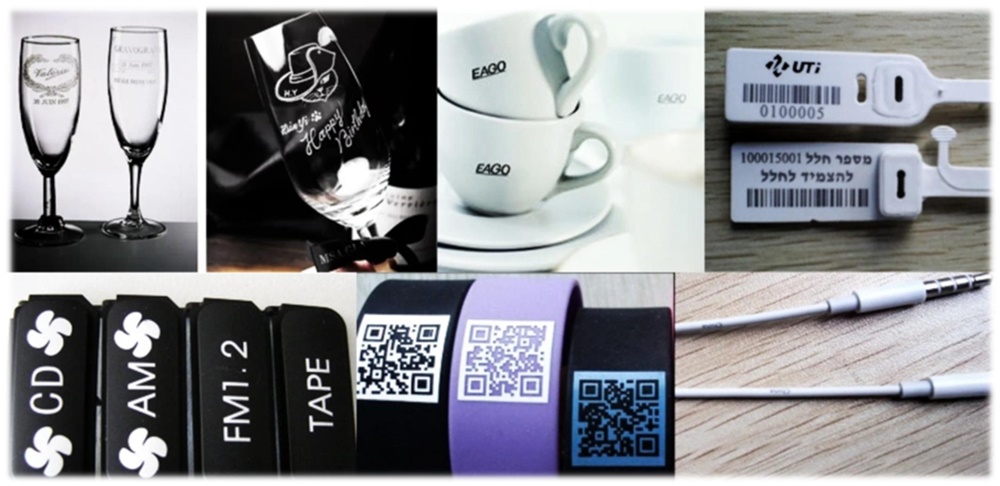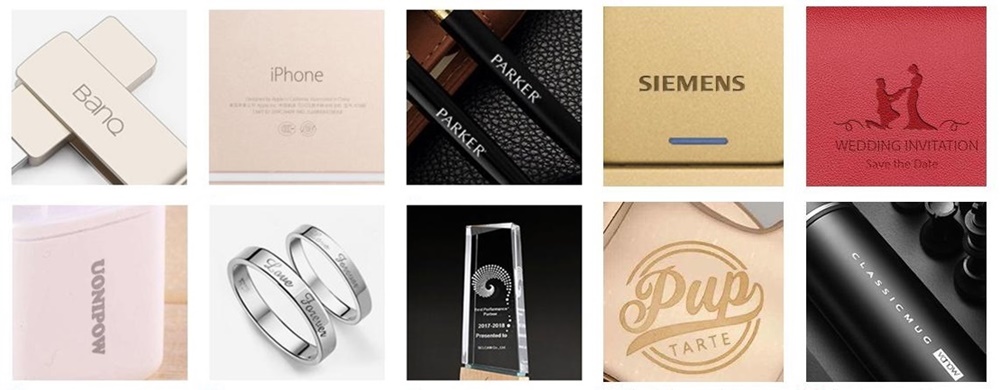The biggest difference between UV and fiber laser machines is the laser wavelength. The UV laser beam operates at a wavelength of approximately 355 nm, in the ultraviolet (UV) range. This short wavelength allows for precise and cold marking, minimizing damage to materials. The fiber laser beam operates at a wavelength of 1064 nm, in the infrared (IR) range. This longer wavelength is better suited for metals and some plastics. Their performance differences are obvious in industrial applications. Here are some key metrics:
Marking Speed and Quality
UV laser marking machines are typically slower than fiber laser coders due to lower power, generally 3W, 5W and 10W for the former, and 20W, 30W and 50W for the latter, but provide high-quality, precise markings with minimal thermal effect, which is ideal for sensitive materials. Fiber lasers have faster marking speeds with high efficiency, especially effective for metals. It generally has lower quality on softer materials and plastics compared to UV lasers due to higher heat generation.
Marking Precision
UV Lasers are highly precise due to the rather smaller beam spot size, allowing for finer details and higher-resolution markings. Fiber lasers are also precise but have a larger beam spot size compared to UV lasers, which may limit precision slightly on very small or intricate designs.
Heat Generation
UV lasers produce minimal heat due to "cold marking," which reduces the risk of damaging heat-sensitive materials. This makes it ideal for plastics, glass, and other materials that deform or discolor under heat. Fiber lasers generate more heat, which can affect heat-sensitive materials and result in the melting or discoloration on certain plastics.
Working Hours and Lifespan
UV lasers generally have a shorter working lifespan compared to fiber lasers, with around 8,000 to 20,000 hours depending on usage. For examples, the service life of Meenjet flying UV laser marking machine is a typical 20,000 hours. Fiber lasers have a longer operational lifespan, often up to 100,000 hours. Meenjet flying fiber laser marking machine has a 100,000-hour lifespan.
Machine Maintenance
UV laser requires more maintenance, especially for higher precision parts, which may wear out faster under continuous operation. UV optics and components are generally more sensitive. Fiber laser has lower maintenance requirements due to fewer moving parts and a more stable, solid-state design. Ideal for high-volume and continuous production.
Cost
UV marking equipment is more expensive upfront and to maintain, mainly due to its specialized optics, components, and precision. This is why it is generally used in industries where quality and precision are prioritized over cost. Fiber laser' total ownership cost is lower in comparison to UV lasers, especially for marking on metals and non-sensitive plastics.
Laser UV marking machines can mark a wide range of materials, especially those that are sensitive to heat. Thanks to their short wavelength (355 nm) and "cold marking" process, UV lasers are ideal for marking delicate or heat-sensitive materials with minimal thermal effect. Here’s a list of commonly marked materials:

Plastics: Like PE, PP, PS, PC, ABS and PVC.
Glass: soda-lime glass, borosilicate glass, quartz glass
Ceramics: alumina, zirconia, and other industrial ceramics
Metals (Coated and Painted): Anodized aluminum, painted steel, coated metals
Silicon Wafers: UV laser is excellent in marking silicon wafers for its low heat and high precision
Paper and Cardboard: Paper labels, packaging, and cardboard (like carton box)
Leather and Textiles: Synthetic and Natural Leathers, Fabrics
Rubber: Synthetic and natural rubber
Wood: light-colored woods and treated woods
Application video: UV Laser Marking on Camera Lens
Fiber laser marking machines are highly versatile and effective for marking a wide variety of materials, particularly metals and certain hard plastics. Operating at a wavelength of 1064 nm, fiber lasers are known for their ability to generate intense heat, making them ideal for durable, high-contrast markings. Here’s a list of commonly marked materials:

Metals: steel (stainless, carbon, alloy), aluminum (anodized and bare), copper and brass, titanium and alloys, precious metals (gold, silver, platinum), coated or plated metals
Certain Plastics: high-performance plastics, dark or filled plastics
Ceramics: industrial ceramics (alumina, zirconia), glazed ceramics
Carbon and Graphite Materials
Composites: carbon fiber, kevlar, and glass-filled composites
Some types of leather: natural and synthetic leather
Wood: only dark woods or coated woods
Stone and Marble: such as stone, granite, marble, and slate
Video: Fiber Laser Marking on PVC hose
UV laser printing machines are widely used across industries that require high precision and minimal heat-affected marking, particularly where sensitive materials are involved. Here’s a look at some of the main industries using UV laser marking and examples of products typically marked in each:
1. Electronics Industry: Printed circuit boards (PCBs), microchips, semiconductor components, capacitors, resistors, and connectors.
2. Medical and Pharmaceutical Industry: Medical devices (scalpels, surgical tools, implants), syringes, test tubes, plastic medical packaging, blister packs, and pharmaceuticals.
3. Aerospace and Automotive Industry: Plastic and composite parts, glass displays, coatings on control panels, wiring harnesses, and components with high heat sensitivity.
4. Packaging Industry: Plastic bottles, glass containers, pharmaceutical packaging, food packaging, and cosmetic containers.
5. Jewelry and Luxury Goods Industry: Glass, plastic, or leather components, as well as designer labels, brand logos, and authentication marks on watches, jewelry, and other luxury items.
6. Cosmetics Industry:Glass, plastic, and coated containers, tubes, and compact cases.
7. Watchmaking and Optical Industry: Glass lenses, contact lenses, watch crystals, precision instruments, and optics.
Read more: UV Laser Marking Machine Used in Optical Manufacturing Identification
8. Food and Beverage Industry: Glass and plastic bottles, food containers, and packaging films.
9. Semiconductor Industry: Silicon wafers, solar cells, integrated circuits, and microprocessors.
10. Research and Laboratory Equipment:Laboratory glassware, plastic vials, petri dishes, and other equipment.
11. Textiles and Apparel Industry: Synthetic fabrics, labels, leather, and plastic clothing accessories.
When choosing between UV laser and fiber laser marking machines, here's a cheat sheet for you to quickly decide which type is suitable for you. However, if you have enough time and patience, reading the content above will benefit you more before making the choice.
Aspect | UV Laser | Fiber Laser | What to Consider |
Suitable Materials | Best for plastics, glass, ceramics, coated and painted metals, paper, and cardboard, leather and textiles, rubber and wood | Primarily for metals. And some ceramics, high-performance plastics, composites, leather, darkor coated wood, and stone and marble | Consider the main materials you’ll be marking. Fiber lasers are excellent with metals, while UV lasers are versatile with non-metals |
Wavelength | 355 nm | 1064 nm | If you need extremely fine details, especially on heat-sensitive materials, UV lasers are better. If you need faster printing speed, especially on metals, fiber lasers are better |
Marking Speed | Moderate, high-quality in low-volume production | Faster, high-efficiency in large-volume production | |
Marking Quality | Very high, precise and accurate, low heat | Good, high heat for metals | |
Precision | Extremely high precision | High but less for intricate work | |
Heat Generation | Low ("cold marking") | High (can cause melting/discolor) | |
Marking Depth | Typically less than 0.1 mm | Typically ranging from 0.1 mm to over 1 mm | |
Working Hours | 8,000 - 20,000 hours | Up to 100,000 hours | Assess your upfront budget, and long-term maintenance and operation cost |
Maintenance | Higher maintenance; Sensitive to overheating | Lower maintenance | |
Cost | No consumables. Higher upfront cost and maintenance | No consumables. Lower upfront cost and maintenance |
If after you have assessed the material, marking depth, production speed, and other application-specific factors, but are still concerned about the printing effect, it would be better to send a few pieces of your product samples to the laser marking machine supplier and ask them to print with both the UV and fiber laser marking machines according to your requirements to check the coding effect. Meenjet has offered many customers sample printing services of different substrates all over the world.